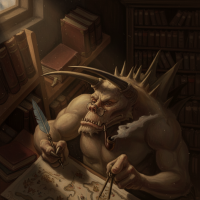
Wyvern
Wyvern
About
- Username
- Wyvern
- Joined
- Visits
- 3,125
- Last Active
- Roles
- Member
- Points
- 5,360
- Rank
- Cartographer
- Badges
- 24
-
[Atlas Submission] - Doriant - Gold Coast - Eknapata Desert - Kukaar
And for @Royal Scribe: I remember seeing this map quite a while back; most impressive still, even though I assumed it had gone into the Atlas back then as well!
Mind you, I'm forever finding maps by others I don't recognise when hunting for places to fit my latest Dungeon24/25/26... maps to. I suspect some probably were never posted about on the Forum, though it's at least as likely I've simply forgotten about them in the intervening years.
-
Live Mapping: OSR Dungeons
Impressed you managed to create anything at all while also trying to watch what Ralf was doing @Don Anderson Jr., and keep an eye on the livechat! And it looks good, too!
As Sue said, this is such an early style, it's one that the effects aren't automatically preloaded when you open the file; that's easily amended, but it can be annoying sometimes if you don't realise and wonder what's happened to the map (from frequent personal experience 😏).
-
OSR Dungeons - The Goblin Outpost and the Lost Tomb
Fragmented walls are - as shown - for surface ruins, although you could use them for a partially collapsed underground area too. The symbols in this OSR style can be as versatile as you make them, mostly because they're not always obvious as to what they're meant to be (name-labels notwithstanding!).
-
Hex Crawl Test
-
Live Mapping: OSR Dungeons
@Loopysue said: At the last count I think there were already more than 200 of them.
I'm sure we're all shocked to learn you don't remember every one, and all the time-codes for every single item discussed in them, Sue 😉!
-
Printing maps from PDF?
I haven't done a lot of printing to true scale like this. However, when doing test prints of any map, I simply save it as a rectangular section .JPG, then transfer that image to MS Publisher (albeit not for much longer, as MS is to withdraw support and cease the program shortly...), because there, I can set the image up exactly where I want it, at exactly the size I need, on whatever paper size I want. That can then be printed directly, or printed to a PDF, or saved whatever other way seems best.
The main reason I do this is because I've had horrendous problems trying to print directly from CC3 and CC3+ in the past, with fills printing weirdly, or with odd colours, etc.
If you want to try this, save the entire map as a .JPG at the exact size you need the full map to be when printed out, and leave the cutting-up into pages till you have it in a program where you can do that more easily - or the GM can, if that may be better (in case their printer doesn't like the PDFs you've prepared). As Don said, bleeping printers!
-
WIP - Wayward Village and Inn
-
Vampire City
-
New Encounter sites along the Shattered Road
-
Printing maps from PDF?
Just following-up here on my earlier comments re the free LibreOffice program "Draw", as I finally got around to installing and doing some basic testing of it earlier today, so can confirm it will indeed open MS Publisher files OK. Not sure it has all the same functionality as yet - as usual, it takes forever to find where the programmers have hidden the features I'm most likely to use regularly - but it does open files with finished images, Publisher-drawn diagrams and photos, and they're all there. The only thing I did notice is that a couple of photos I'd resized after cropping in Publisher had become a little distorted, although resizing by-eye corrected their appearance at the expense of enlarging the images, which would then need resizing to fit the text again. I'd guess that would probably work better if I'd cropped and resized the image in Draw, though I hadn't time to check that would work. Hopefully, this may assist anyone hunting around for an MS Publisher substitute when the program's withdrawn by Microsoft next month.




